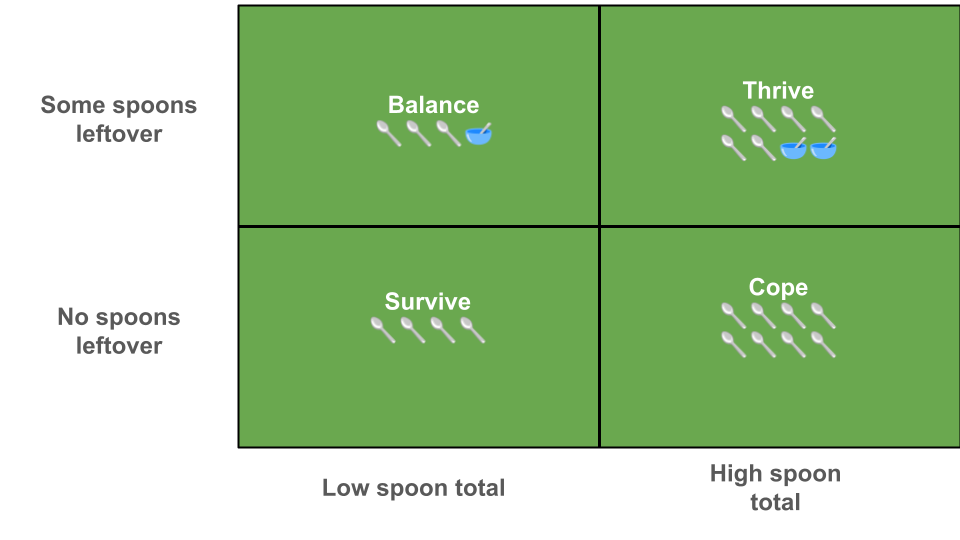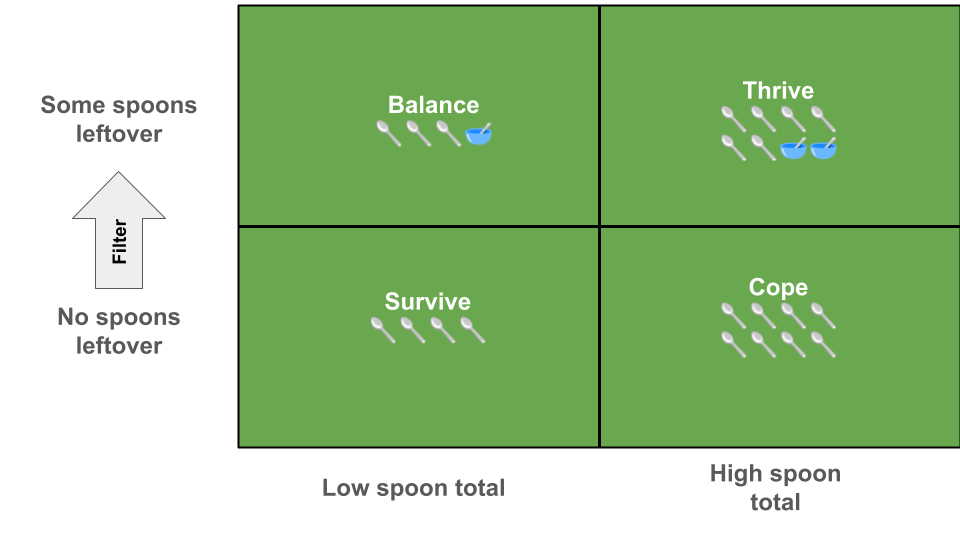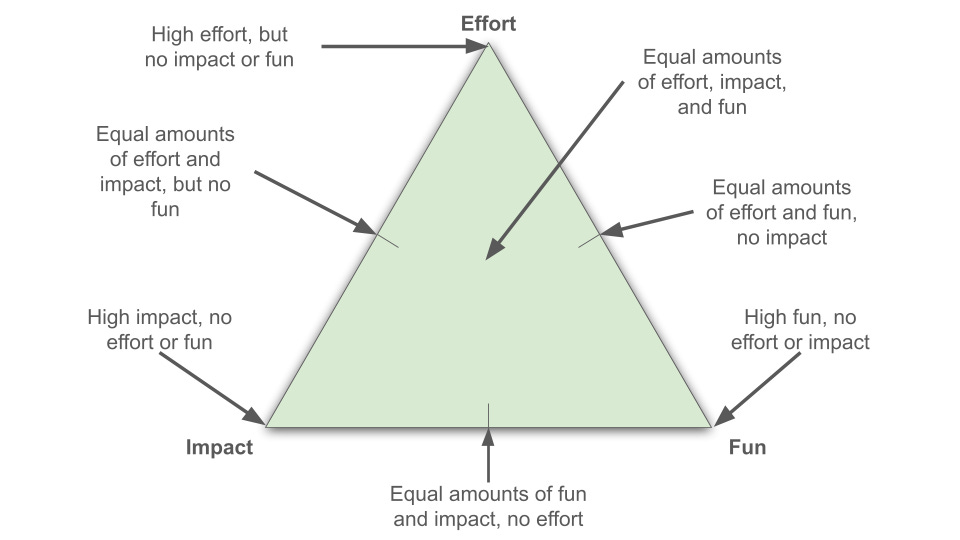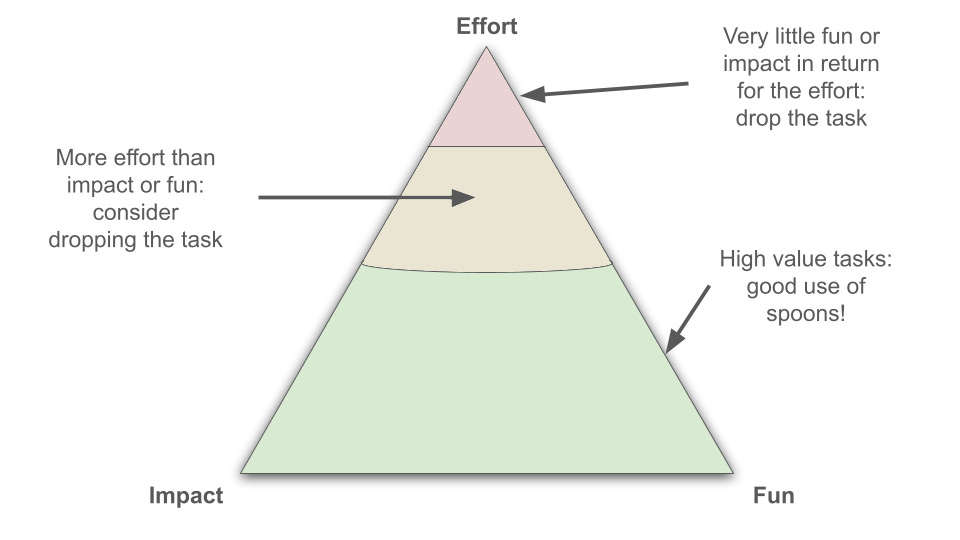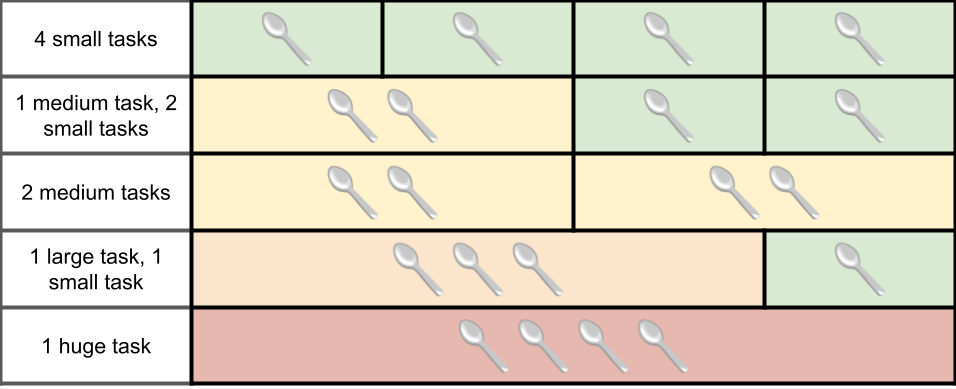Spoons are a representation of energy available to each person. A task takes a certain amount of spoons for a particular person, and each person has their own spoon capacity. Insight into your effort spent is vital for ensuring that time is well spent.
Energy spent when you have extra capacity is different from when you barely have enough spoons per day. I separate these myself through thinking of two modes: surviving, and thriving.
When in surviving mode, there's a lack of spoons. Things that I need to do take much higher priority than those I would like to do. However, this mode of thinking requires sacrificing something I would benefit from doing.
In surviving mode, one of two things is true:
I am barely able to keep up with the things I need to do, and therefore are really struggling.
I'm able to do the things I need to do, but I have no capacity for anything enjoyable.
When in thriving mode, one of two things is true:
I have more spoons available to me
I have the same amount of spoons, but I am using my spoons more effectively
The following diagram shows this as a matrix.
In this post, I’ll focus on the shift between “No spoons leftover” and “Some spoons leftover”. In a future post, I’ll go into how circumstances so that there’s a higher total of spoons available to an individual.
For those with a low spoon count, they must optimize the use of spoons based on things that need to be done.
When spoons are low, extroverts might regain some energy by hanging out with friends. Introverts might read a book, or play a game. The spoons regained are usually temporary - if a person returns to their “needs to have”, they’ll only have a temporary boost in energy.
The concept of saving spoons isn’t to gain as many spoons as possible, but to use those you have available to you most effectively. Stretching your energy too thinly will make you less effective at all tasks.
Depending on your capacity and goals, you might choose to use your spoons differently. I personally aim for a mix of things I enjoy doing, things that I must do, and things that help me grow. Some tasks are all three. Others might be only one.
Before optimising, there must be historical data on how spoons have been spent. I do this individually through a “win log”: a spreadsheet tracking spoons spent.
Metrics
Every task I track has 3 metrics:
The fun I had doing it
The amount of effort it took me
The impact it had
Fun is straightforward: how much did I enjoy the task or the results of a task? Some examples:
I have a lot of fun playing games with close friends.
I don’t enjoy cleaning.
I enjoy the results of cooking.
Some examples of effort:
Playing games with close friends does not take much effort. Playing games with unknown people takes more effort, as I need to mentally prepare.
Cleaning takes a substantial amount of effort.
Cooking takes some effort, but it can be a wide range. Making a toastie requires little effort, whereas making lasagne requires a lot of effort.
Examples of impact:
Playing games usually will lift my mood for a period after the task, making the short-term impact relatively high. But my mood will only be lifted temporarily, making the long-term impact low.
Cleaning results in a healthier environment, simplifying a lot of chores. Therefore the impact is high.
Cooking is cheaper and healthier than eating out or takeout, so the impact is high on costs and health. However, ordering takeout still would meet the core need, so the overall impact is mid.
Using this way of mapping tasks, we can see clear areas where tasks are more effort than their return.
Tasks that are reoccurring should be evaluated on the value they bring. If it is not fun and has a low impact, it is probably not worth doing so frequently. Reducing the frequency frees up spoons for other tasks instead.
One-off tasks, particularly those which are done for the first time, can help broaden your horizon. If the task isn't valuable, it probably should not be repeated.
How to distribute spoons
Not all tasks are equal in effort. Some tasks might require all your spoons, others might only need one. The majority of tasks throughout the day are small tasks, and bigger tasks are often composed of many smaller tasks.
Depending on your priorities, you might prefer small tasks or a bigger task. I personally prefer many small tasks, as they allow me to make progress towards some bigger goal while balancing several priorities. However, sometimes a bigger task, like talking at a conference, can have a bigger impact or fun than several small tasks.
Finding the distribution that works best for you is individual, however the best way to get there remains the same - by tracking your effort spent. For paying subscribers, I’ve shared my tracking template below - but any form of tracking is better than no tracking.
The next blog post will go into more detail on the circumstances where a total spoon count available to a person might increase or decrease, and the implications that has for capacity.
Keep reading with a 7-day free trial
Subscribe to Saving Spoons to keep reading this post and get 7 days of free access to the full post archives.


